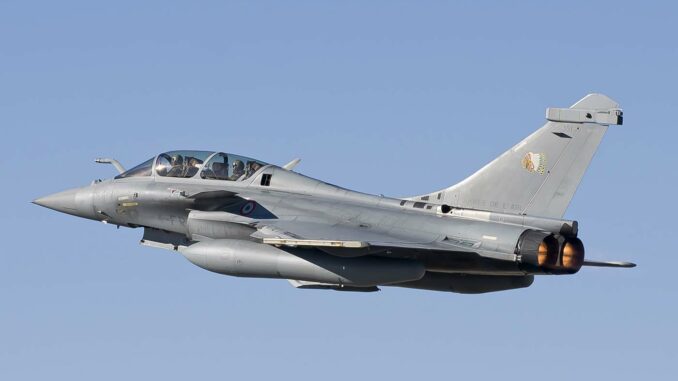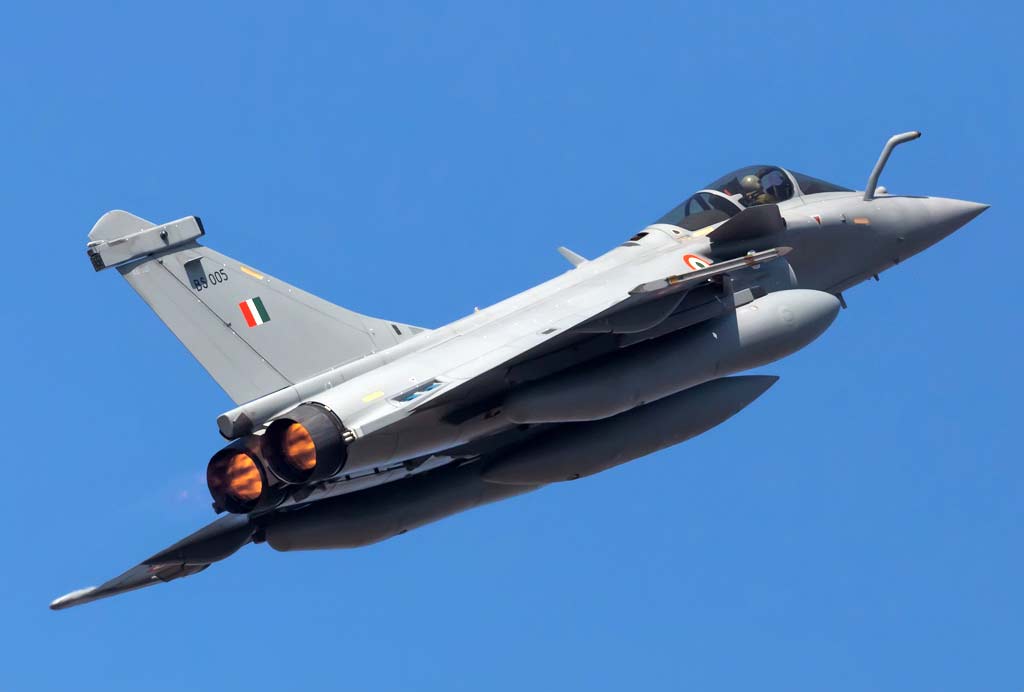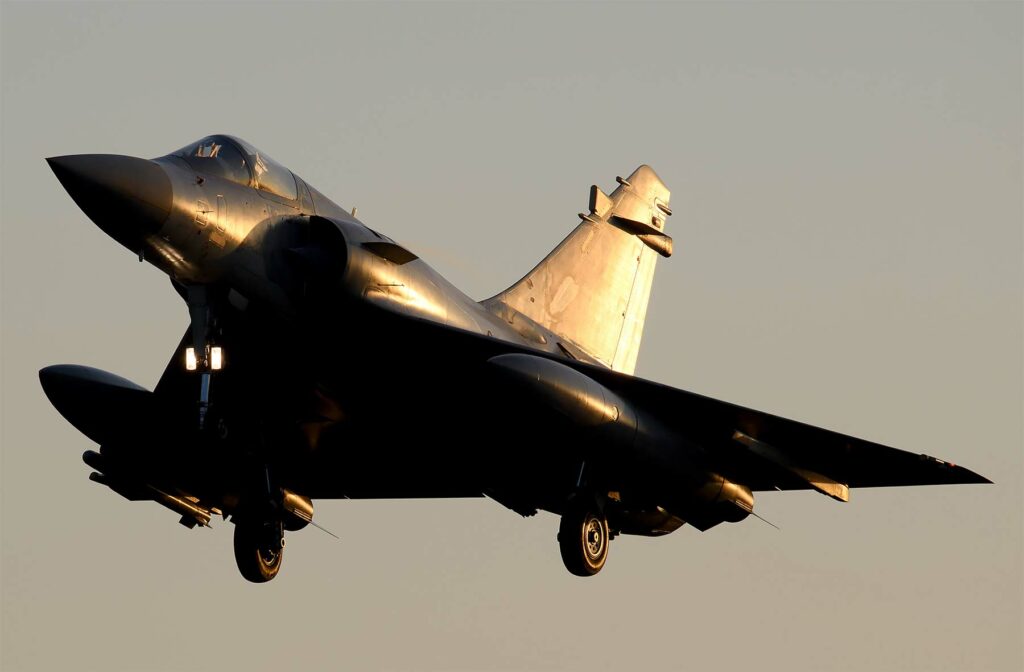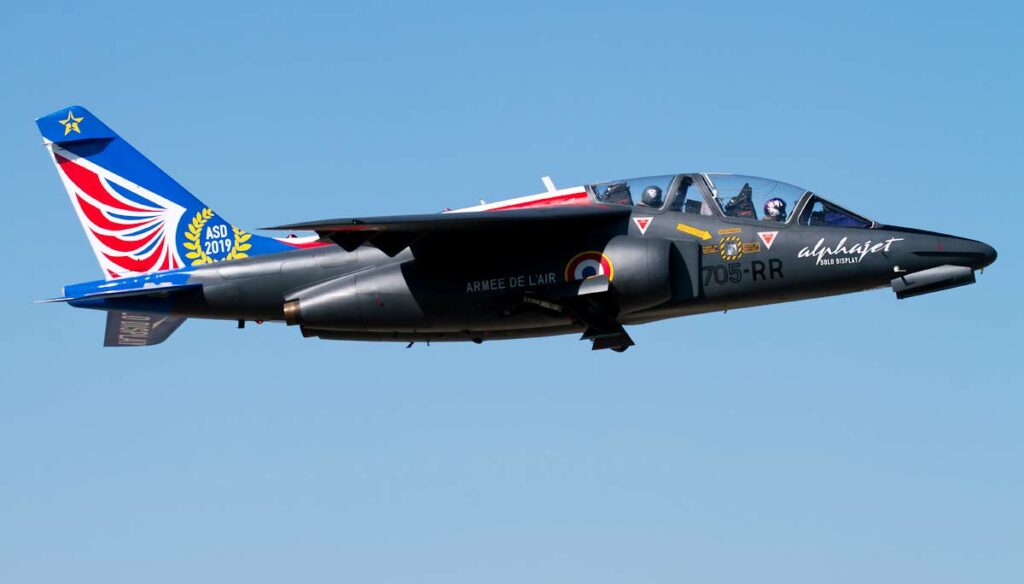
Discover the aircrafts of the French Air Force, from their history to their current roles and future projects.
The French Air and Space Force plays a crucial role in national defense, using a varied fleet of aircraft to meet the multiple demands of air safety. Founded in 1909, it has evolved to include not only combat aircraft, but also transport, training and reconnaissance aircraft, adapting its missions to France’s contemporary needs and its presence on the international stage.

History of French Air Force aircrafts
The French Air Force, now known as the Armée de l’air et de l’espace, was officially established in 1909, marking the start of a history rich in technological developments and strategic advances. From the outset, it integrated balloons for reconnaissance missions during the Franco-Prussian War, and soon afterwards, the first aircraft were adopted for military use.
Evolving technologies and capabilities
The First World War was a technological pivot for the French Air Force, using aircraft for reconnaissance, bombing and combat missions. During this conflict, France became a leader in the development of air tactics and aircraft production, with output reaching over 2,700 aircraft per month in 1918.
Between the two world wars, the Armée de l’Air continued to develop, experimenting with new aircraft designs and tactics, such as the use of dive bombers. This laid the foundations for one of the most technologically advanced air forces on the eve of the Second World War.
After the Second World War, the introduction of jets such as the Mirage and later the Rafale ushered in an era of air superiority, with aircraft capable of fulfilling multiple roles on the battlefield. The Mirage 2000, for example, introduced in 1984, has been a mainstay of the force, capable of nuclear penetration operations and automated bombing using guided munitions.
Fighter aircraft
Fighter aircraft used by the French army
The French army uses several types of fighter aircraft to carry out its air defense, assault and reconnaissance missions. Fighter aircraft currently in service include :
Rafale: Designed by Dassault, the Rafale is a multi-purpose fighter that can carry out a wide range of military missions. There are different models of the Rafale, including the standard F1, F2, F3 and F4, each offering enhanced capabilities over previous versions.
Mirage 2000-5: A modernized version of the Mirage 2000 family, the Mirage 2000-5 features advanced air-to-air and air-to-ground combat capabilities.
Mirage 2000 D: Specifically designed for ground attack operations, the Mirage 2000 D is a derivative of the Mirage 2000N, adapted for precision strike missions.
Mirage 2000 C: This is the initial version of the Mirage 2000 family, mainly used for interception and air superiority missions.
Focus on the Rafale
The Rafale is a multi-role fighter designed to perform a wide variety of military missions, making it essential to France’s defense strategies.
Developed and manufactured by Dassault Aviation, the Rafale is capable of operating from both land bases and aircraft carriers. This twin-engine, delta-wing fighter is equipped to carry out several types of mission, including air supremacy, air defense, close air support, deep strikes, reconnaissance, anti-ship strikes and nuclear deterrence. It is available in three variants: Rafale C (single-seater for land operations), Rafale B (two-seater for land operations) and Rafale M (single-seater for carrier-based operations).
Typical fighter roles and missions
Rafales play a crucial role in rapid reaction and airspace defense (QRA) operations, as well as in nuclear deterrence, power projection and support for external operations. They are also involved in deep strike, land force support and reconnaissance missions. The Rafale’s flexibility enables it to carry out several different missions on a single sortie, underlining its role as a force multiplier for the French air force.
The Rafale has proven its effectiveness in a variety of international conflicts, taking part in combat missions in Afghanistan, Libya, Mali, Iraq and Syria. Its ability to carry out precision strikes has been demonstrated on several occasions, using weapons such as AASM/HAMMER laser-guided bombs and SCALP cruise missiles for deep strikes.

Transport and tanker aircraft
The French Air Force operates a diverse range of transport and tanker aircraft, essential for logistical support operations and force deployment. These aircraft are crucial for transporting troops and equipment, and for air-to-air refueling, significantly extending the range and endurance of airborne missions.
Transport aircraft
- Airbus A400M Atlas: This tactical and strategic transport aircraft is designed to carry out a wide range of missions, including transporting large loads and parachuting personnel and equipment. It can operate from minimally equipped runways, increasing its operational flexibility.
- Lockheed C-130 Hercules: Used for a wide range of missions including tactical transport, special forces refueling and medical evacuation, the C-130 is a mainstay of military air transport, thanks to its ruggedness and versatility.
- CASA CN-235: Optimized for tactical transport, this aircraft can carry troops and equipment, and is also used for general logistics missions. Its smaller size enables it to access smaller, less well-equipped airfields.
Supply aircraft
- Boeing KC-135 Stratotanker: Specifically designed for in-flight refueling, the KC-135 is fundamental to extending the range of fighter jets and other combat aircraft, enabling them to stay on mission longer without having to return to base for refueling.
- Airbus A330 MRTT Phénix: The versatile A330 MRTT is both a tanker and a strategic airlifter. It is equipped with advanced refueling systems that enable it to support a variety of aircraft, increasing the effectiveness of combined air operations.
Importance of supply and logistic transport missions
Transport and supply aircraft play a vital role in maintaining the continuity and effectiveness of military operations. They enable the air force to respond rapidly to the demands of international missions, to take part in humanitarian operations and to fulfill its defense and security commitments. The ability to conduct extended air operations far from the main base is a strategic asset, facilitating power projection and overall support for operations.
Reconnaissance and surveillance aircraft
The French Air Force uses a variety of aircraft and UAVs for reconnaissance and surveillance missions, playing a crucial role in intelligence, surveillance and reconnaissance (ISR) operations.
Aircraft and UAVs used for reconnaissance and surveillance
- Dassault Falcon 7X: Adapted for surveillance and reconnaissance missions, this business jet has been modified to meet the Air Force’s specific intelligence-gathering requirements.
- Dassault Mirage 2000 RDI/2000-5 : Mainly used as fighter aircraft, some Mirage 2000 are equipped for reconnaissance missions thanks to specialized reconnaissance pods.
- Airbus A330 Phénix: In addition to its refueling and transport roles, the A330 MRTT Phénix can also be configured for strategic surveillance missions, thanks to its endurance and ability to carry specialized equipment.
- E-3F Sentry AWACS: The Boeing E-3 Sentry is an air surveillance and command aircraft that provides a global, real-time picture of the airspace, enabling effective management of air operations and early detection of threats.
- DRAC (Drone de Reconnaissance Au Contact) : This drone provides close surveillance and reconnaissance in hard-to-reach areas, complementing the air force’s reconnaissance capabilities.
- Beechcraft King Air 350: Referred to as ALSR (Avion Léger de Surveillance et de Reconnaissance), this aircraft is equipped for ISR missions, including electromagnetic surveillance and imaging. The King Air 350 is valued for its ability to operate with a reduced logistical footprint, and can be rapidly deployed in a theater of operations.
- MQ-9 Reaper: Deployed in Niamey, Niger, for Operation Barkhane, these medium-endurance, high-altitude surveillance UAVs are essential for reconnaissance and support missions in the Sahel region. They are operated by the 1/33 Belfort UAV squadron and the 3/33 Moselle UAV operational transformation squadron, which are responsible for initial crew training.
Strategic importance of aerial surveillance
These surveillance and reconnaissance platforms are vital for acquiring accurate, real-time intelligence, enabling the French air force to monitor potential threats, support ground operations and ensure airspace security. The ability to carry out complex and diversified surveillance missions is a strategic asset, facilitating power projection and overall support for military operations.

Training and training aircraft
The French air and space force uses a variety of training aircraft to prepare its pilots for the demands of military flying, from basic piloting to advanced air combat.
List of aircraft used for pilot training
- Socata TB-30 Epsilon: This single-engine aircraft is used for basic training. It introduces student pilots to the fundamentals of flight, including piloting, navigation and various aerial maneuvers. This model is particularly appreciated for its ability to operate from unprepared runways or grassy fields, offering great training flexibility.
- Pilatus PC-21: Used for advanced training, the Pilatus PC-21 is a turboprop that offers an efficient transition to fighter jets thanks to its high performance and advanced systems. This model is currently in use at the Cognac flying school, marking a modernization of the French Air Force’s pilot training syllabus.
- Dassault/Dornier Alpha Jet: Once a mainstay of advanced combat and ground attack training, the Alpha Jet has recently been replaced by the Pilatus PC-21 for pilot training. However, it continues to play a role in opposing formations and is used by the Patrouille de France for aerial demonstrations.
- Extra 330LC: Although primarily an aerobatic aircraft, the Extra 330LC is used by the French Air Force aerobatic team to train pilots in advanced flying techniques and manual piloting in extreme situations.
Importance of initial and ongoing training
Initial and ongoing training is essential to prepare pilots to effectively operate modern air force and space aircraft. Each type of training aircraft contributes to building the skills needed at each stage of their military career, ensuring that pilots have the necessary competencies to carry out their missions competently and safely.
Modernization and the future
Fleet modernization projects
The French army has undertaken several significant projects to modernize its air fleet. One notable example is the €1.2 billion contract signed with Airbus for the renovation and maintenance of the A330 MRTT fleet, as reported by Les Echos. This initiative is aimed at improving in-flight refueling capabilities, crucial for long-distance operations. In addition, according to the same source, this modernization includes the installation of new avionics and communications systems, enhancing operational efficiency and mission safety.
In addition, information from Defense.gouv.fr highlights the start of an extensive transformation since 2017 as part of the 2019-2025 Military Programming Law. This program aims to strengthen France’s defensive capabilities through the acquisition of advanced technologies and new aircraft. Modernization not only concerns transport and refueling aircraft, but also fighter jets such as the Rafale, which according to Opinion is seeing an acceleration in the updating of its systems to stay at the cutting edge of technology.
Investment in cutting-edge technologies and new aircraft
Investment in cutting-edge technologies is at the heart of the French army’s modernization strategy. Priority is given to the development and integration of modern avionics systems, more powerful sensors and secure communications. These improvements will enhance mission performance and operational efficiency.
The adoption of new aircraft also plays a crucial role in the modernization plan. For example, as reported by air.defense.gouv.fr, the integration of the A330 MRTT Phénix into the fleet represents a significant step forward. These new-generation refueling aircraft offer superior versatility and payload capacity, essential to support complex and prolonged operations.
The future of the French air force also looks promising with the nEUROn stealth combat drone trial, mentioned on Cairn.info. This project illustrates the interest in autonomous vehicles and stealth technologies, aimed at providing innovative solutions for future challenges.
War Wings Daily is an independant magazine.